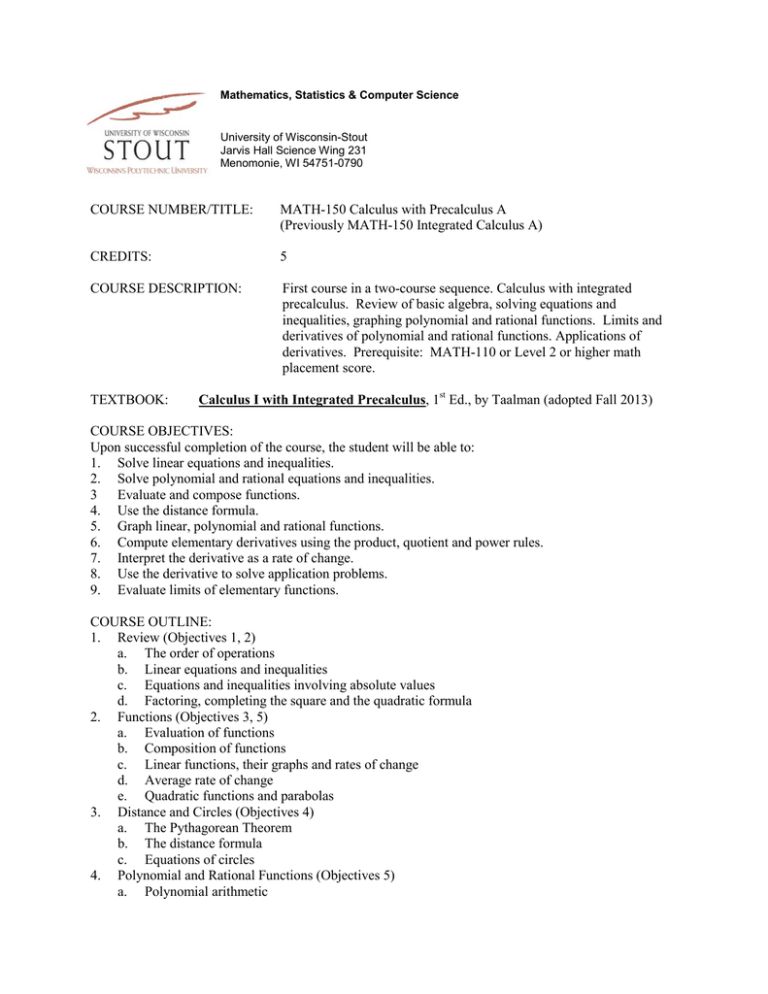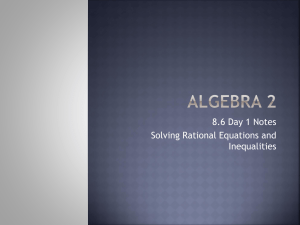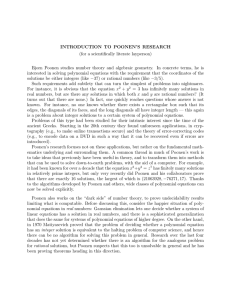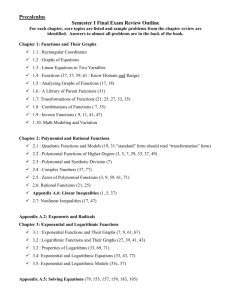COURSE NUMBER/TITLE: MATH-150 Calculus with Precalculus A (Previously MATH-150 Integrated Calculus A)
advertisement

Mathematics, Statistics & Computer Science University of Wisconsin-Stout Jarvis Hall Science Wing 231 Menomonie, WI 54751-0790 COURSE NUMBER/TITLE: MATH-150 Calculus with Precalculus A (Previously MATH-150 Integrated Calculus A) CREDITS: 5 COURSE DESCRIPTION: First course in a two-course sequence. Calculus with integrated precalculus. Review of basic algebra, solving equations and inequalities, graphing polynomial and rational functions. Limits and derivatives of polynomial and rational functions. Applications of derivatives. Prerequisite: MATH-110 or Level 2 or higher math placement score. TEXTBOOK: Calculus I with Integrated Precalculus, 1st Ed., by Taalman (adopted Fall 2013) COURSE OBJECTIVES: Upon successful completion of the course, the student will be able to: 1. Solve linear equations and inequalities. 2. Solve polynomial and rational equations and inequalities. 3 Evaluate and compose functions. 4. Use the distance formula. 5. Graph linear, polynomial and rational functions. 6. Compute elementary derivatives using the product, quotient and power rules. 7. Interpret the derivative as a rate of change. 8. Use the derivative to solve application problems. 9. Evaluate limits of elementary functions. COURSE OUTLINE: 1. Review (Objectives 1, 2) a. The order of operations b. Linear equations and inequalities c. Equations and inequalities involving absolute values d. Factoring, completing the square and the quadratic formula 2. Functions (Objectives 3, 5) a. Evaluation of functions b. Composition of functions c. Linear functions, their graphs and rates of change d. Average rate of change e. Quadratic functions and parabolas 3. Distance and Circles (Objectives 4) a. The Pythagorean Theorem b. The distance formula c. Equations of circles 4. Polynomial and Rational Functions (Objectives 5) a. Polynomial arithmetic 5. 6. 7. 8. b. Long and synthetic division algorithms c. Polynomial equations and inequalities d. Rational equations and inequalities e. Graphing polynomial and rational functions Differentiation of Polynomial and Rational Functions (Objective 6) a. Derivatives of monomials b. Linearity of the derivative c. The product, power, and quotient rules d. Combining rules of differentiation The Derivative as a Rate of Change (Objectives 5, 7) a. Instantaneous rate of change b. The Mean Value Theorem and Rolle’s Theorem c. Intervals where functions increase/decrease d. The second derivative, concavity, and inflection points e. Optimization on a closed interval f. Relative maximums and minimums, the first and second derivative test g. Graphing functions using their derivatives Applications of Differential Calculus (Objective 8) a. Constrained optimization problems b. Implicit differentiation c. Related rates Limits (Objective 9) a. Limits of rational functions and roots b. Epsilon‐delta proofs of limits c. The limit definition of derivative d. One sided limits e. Infinite limits Updated 8/2015 Revised 4/2013 1/2011





